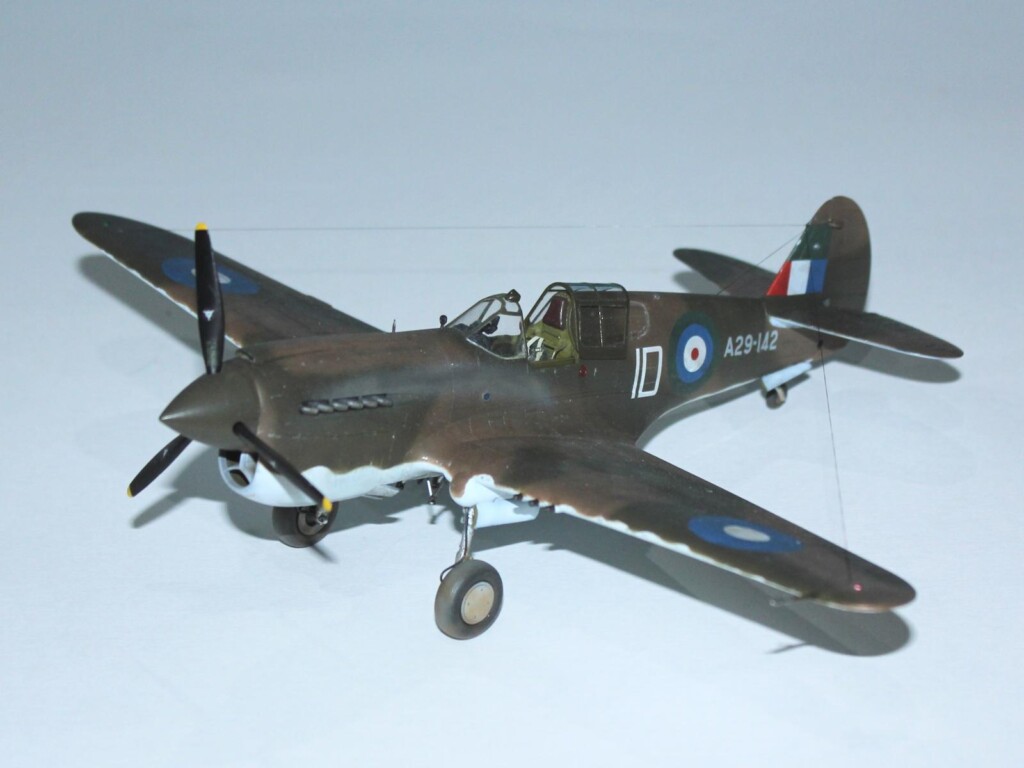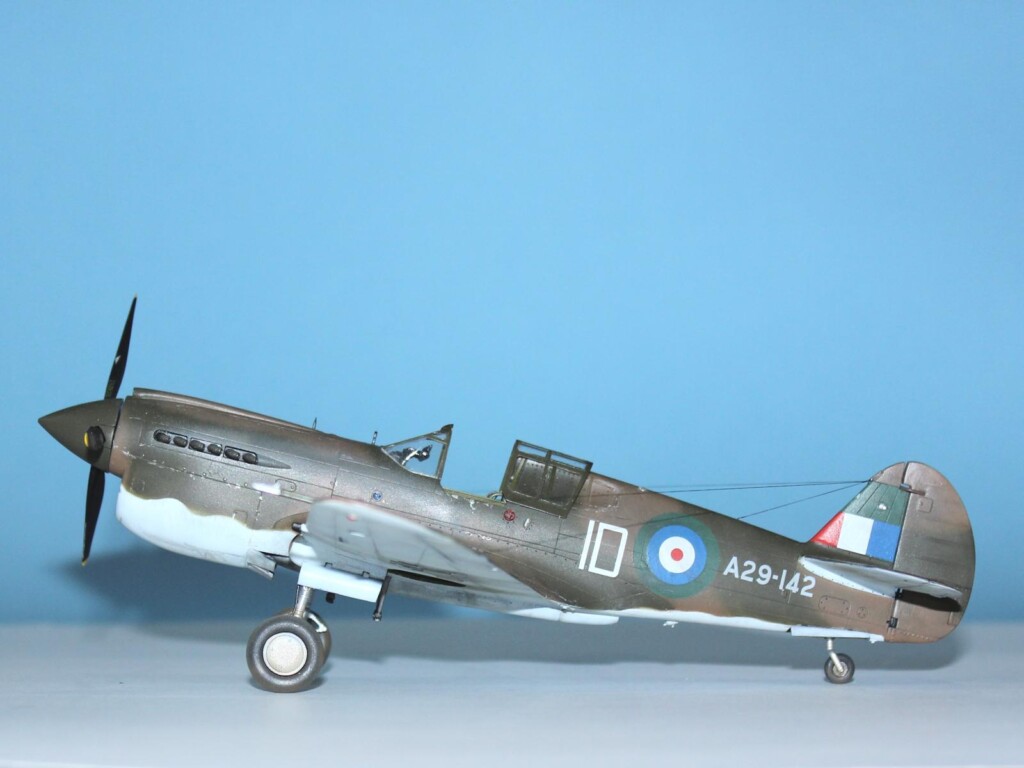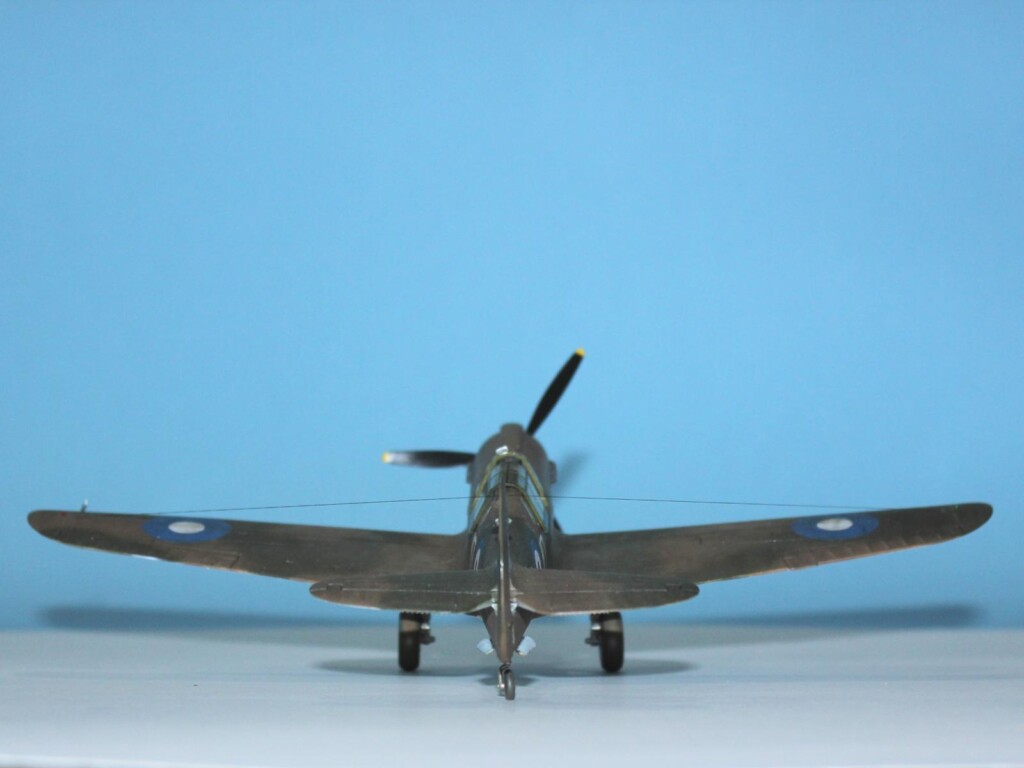P-40 in the Battle of Milne Bay
This the third of six P-40s I built earlier this year for a club display for the Australian Model Expo. I built them as one group of three and a second group of four. The seventh aircraft was not finished in time for Expo but is now completed.
- Top P-40 Ace
- P-40 in Defence of Port Moresby
- P-40 in the Battle of Milne Bay
- Free French Fighter
- RAAF over Italy
- Flying Kiwi
- Hep Cat
Subject
This model represents the mount of Squadron Leader Keith William 'Bluey' Truscott, Commanding Officer 76 Sqn., flying from Milne Bay in September 1942.
A little over 3 and a half months after the conclusion of the RAAF's Pacific baptism of fire in the defence of Port Moresby, they faced another critical challenge.
Although the Japanese had suffered a major defeat at the Battle of Midway (4-7th of June 1942), losing four fleet aircraft carriers, they still held the initiative in the south Pacific. With the US landing on Guadalcanal in the Solomon Islands the Japanese sought to secure their flank by completing their conquest of New Guinea.
As a first step toward a seaborne landing at Port Moresby the Japanese planned a landing at Milne Bay to secure the recently completed airfield. The Japanese intelligence was unaware of the strength of the mainly Australian garrison and landed too small a force on the 25th of August. Nevertheless, the ground fighting was intense and the P-40s of 75 and 76 squadrons were in the thick of it, both in intercepting Japanese aircraft raids and supporting the ground troops.
The P-40 managed to destroy the landing craft of a Japanese flanking force and were bombing and strafing Japanese forces almost as soon as they had lifted off from the airfield. They proved the difference and the Japanese withdrew their forces on the 7th of September. The battle was the first major land defeat of the war for the Japanese.
Sqn. Ldr. Keith "Bluey" Truscott had seen combat flying Spitfires in Britain before being recalled to Australia and was the most well-known pilot in the RAAF due to his having played Australian Rules Football with the Melbourne Demons pre-war. He joined 76 squadron and deployed with them to Milne Bay ion July 1942. Leadership of the squadron fell to Truscott when the commander, Peter Turnbull, was killed in action on the 27th of August.
Truscott had achieved 14 and one shared kills, all but one when serving in Britain, at the time of his death during a combat training flight on the 28th of March, 1943.
You can read more about Truscott here (https://imodeler.com/2023/04/honouring-a-wartime-pilot/).
Construction
According to the ADF Serials web site, A29-142 was a P-40E-1, serial number 41-36236. Fortunately for this build, the Hasegawa kit is essentially a P-40E-1.
The "dash 1" refers to P-40Es built to UK specifications as follows:
- Two blue formation lights mounted either side of the fuselage below the cockpit
- An ID light on the spine behind the cockpit
- An ID light lower starboard behind the flaps
- A ring and bead gunsight mounted to starboard on the cowling
- They may also have had a British gun camera mounted under in a fairing under the starboard wing
As the Hasegawa kit provides for all of these features the build was more strait forward than for my P-40E and the build was otherwise identical with the exception that I decided to paint the seat aluminium for a bit of variation. The P-40E-1 was also fitted with a RAF Sutton harness for the pilot, for which I used an Eduard pre-painted etch set.
Again, I reasoned that in the hectic situation 76 Sqn found themselves in, they would be unlikely to have used the gun camera, nor had the facilities to process the film, so I left this off.
Painting and Markings
The markings are based on the reasonably well-known photo of the aircraft that was taken at Milne Bay in 1942.
Based upon this photo, and photos of other aircraft in the squadron, the aircraft had the underside repainted after delivery as is evidenced by the wavy demarcation line. Also, the lower wing is devoid of national roundels, the tail fin flash has been reduced in height by about half and the yellow surround to the fuselage roundel has been clearly painted over. The aircraft A29 serial number is painted in light grey.
76 Sqn had moved to Milne Bay on the 19th of July and were joined there by a refitted 75 Sqn at the end of July. Initially, 76 Sqn aircraft were identified by a single letter but preceded this with an “I” to distinguish them from 75 Sqn. Although not visible in the photo, it is known that Truscott's aircraft was coded “ID”. Photos of other 76 Sqn P-40s from this time show the code letters to be in a narrow sans-serif font.
Again, I used Gunze H78 Olive Drab (2) and Gunze H37 Wood Brown for the Dupont Dark Green 71-003 and Dark Earth 71-009. However, the repainted lower surfaces would have been RAAF Sky Blue for which I used SMS PL156 RAAF Sky Blue (FS 25550).
RAAF insignia in early 1942 still included the red component, which was progressively removed from aircraft. In July, the red was ordered to be removed from the upper wing Type B roundels. The red was retained on the lower wing and fuselage roundels and fin flash at this time, but in September it was ordered removed from these as well. Therefore, this aircraft had the blue/white upper wing roundels with the red retained on the fuselage and fin.
Again, the fuselage roundel area was painted RAAF Foliage Green (SMS PL78 Foliage Green (FS 34092) prior to painting the camouflage scheme and covered with circular masks, this time to the correct diameter. The fin was likewise painted RAAF Foliage Green and masked to replicate the overpainting of the top of the fin flash.
The individual aircraft letters are not visible but photos of other aircraft show them ahead of the fuselage roundel where they would have been obscured in the only photo of this aircraft. As noted earlier, 76 Sqn initially used single aircraft letters with the “I” added ahead of this. Therefore, I reasoned that the “D”s should be aligned either side of the fuselage with the “I” then being offset forward on the port side and aft on the starboard side.
Again, the aircraft was lightly weathered and the small formation lights attached and painted. The lower ID light was painted clear yellow and the fuselage side formation lights painted clear blue.
The final act was to attach the antenna wires.
Again, this was a fun build and I'm extremely happy with the end result. This aircraft represents another challenging and formative time for the Australia and the RAAF.















Well researched and beautifully built, Michael. Particularly nice weathering too!
Great kits, great build, great moment in the history of the RAAF.
Great job, Michael! No matter how you dress em up, ya gotta love the P-40!
Awesome build! I like the color scheme a lot.
Awesome job, awesome result after awesome research, Michael!
Congratulations!
Another beautiful P-40. Really nice work, and the history lesson is much appreciated! I love reading about the combat history of the P-40 and the men who flew and maintained them.
Spectacular build and impressive research into this particular machine.
Great research always leads to a great model, @michaelt.
great paiting and weathering!
Nicely built and researched.
Very nice build, Michael @michaelt
Research is an ejoyable part of modeling as well.
Excellent build - I'm a big fan of the S. Pacific theater - keep them coming!
G'day Ben (@popeofchillitown), Emberson (@embersonfedders), Frederick (@fjs3), Felix (@fxrob), Spiros (@fiveten), Clint (@curtisshawk), Chas (@chasbunch), Tom (@tcinla), Lis (@lis), John (@jdtruby), John (@johnb) and Greg (@gkittinger),
Thanks for having a look and your kind comments.